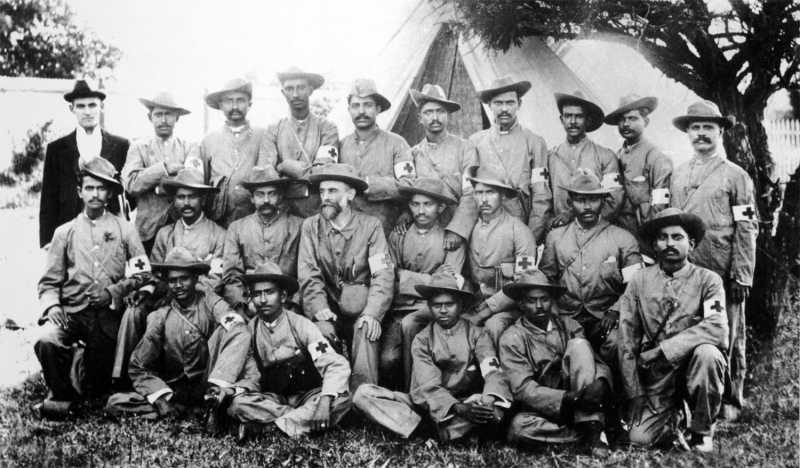Hadra Ahmed reports from Durban on the city which helps Gandhi to formulate his freedom struggle
Once home to the young Mohandas Karamchand Gandhi, the city of Durban in South Africa has more overseas Indians than any other city outside India. Glimpses of India are visible in the sights, smells and sounds of this city on the country’s southern coast.
 The aroma of herbs, spices and curries greet visitors in the Indian and herbal markets of the Indian districts and Grey Street areas and it is common to see Indian women proudly wearing their traditional attire.
The aroma of herbs, spices and curries greet visitors in the Indian and herbal markets of the Indian districts and Grey Street areas and it is common to see Indian women proudly wearing their traditional attire.
South African Indian culture got enriched in 1860 when the first Indian immigrants arrived on board the Truro as indentured labourers to work on sugarcane farms in present day KwaZulu-Natal. In 2010, more than 1.2 million people of Indian descent in South Africa celebrated the 150th anniversary of their ancestors’ arrival in this country. But the influence of the Indian community is not limited to Gandhi, with many members of this community being represented in the government and ruling party in positions of influence and importance.
Indians in this South African city have a language of their own that is very different from the languages spoken by the locals. Local residents and other travellers have to actually surf the internet or find dictionaries to decode the language.
Charous is the local dialect people of Indian descent here use to communicate with one another. The “Durbs” would just swing their heads from left to right while speaking Charous.
“This is a dialect we came up with combining English, Hindi and Afrikaans”, Ishwar Sookraj, a Durban resident, said. “We use it when we get together and when we want to talk about something of our own like family issues or business. It is so convenient because it is our unique identity.”
Terrence Kommal, chief executive of Sutra magazine and Ayush Healthcare of Pretoria, showed the unique character of the community when he planned his wedding in the traditional Indian way as seen in movies.
His wedding culminated in a spiritual ceremony at the ashram of Terrence’s guru, Bhagwan Sri Sathya Sai Baba, in Prashanti Nilayam in Andhra Pradesh, India, April 27 this year. The wedding ceremony itself was conducted by the ashram’s head priest and current head of the Sathya Sai Central Trust.
The next morning, the Kommals flew via New Delhi to Jammu and commuted to Katra where Terrence and his bride, Urvashi, went to seek the blessings of Goddess Vaishnodevi.
“It is customary for Hindus in India to do this immediately after marriage as this is considered very auspicious,” Komal said. “We walked up the 16 km to the holy shrine of Mother Vaishnodevi despite the oppressive heat in Katra at the time.”
Prior to the actual marriage, there were the very colourful mehendi and matkor (prayers to mother earth for her blessings) ceremonies that took place at the Shree Gopala Temple Hall on Plane Street in Durban, April 11.
On May 24, 2014, a grand wedding reception for more than 350 guests was hosted at the plush Hellenic Community Hall in Riverside, Durban North.
“This entire experience was one of extreme divinity and we give all thanks to Sathya Sai Baba for having made everything possible”, the groom said. “No matter where we are we will always keep our traditions. There is no Indian despite the distance from home who leaves behind his or her identity”.
From the Indian spices in the coastal city of Durban and the Indian accent, which has influences of other languages of South Africa, the Indians in Durban have something new to share, according to Davison Mudzingwa, Entrepreneurship Africa Founder and Editor.
“A yearning for the Easter mosaic and an Africa root — both identities that are now indelible part of their oeuvre — adds to the parable oriental influence that defines Durban thanks to the Indian population,” he said.
Durbs or other South African communities who grew up looking at the Indian community are used to the aroma of the food especially found in special Sunday markets.
They sing along with the Hindi songs, try to communicate with the little words they know with Indians and are part of the celebrations.
In addition, cultural ideas and influences are strongly felt here.Tradition has been handed down from generation to generation and preserved in the largest Indian diaspora outside of India.
The sari is seen being worn by Indian women on many South African streets, especially in KwaZulu-Natal. Indian cuisine is hugely popular, with south Indian and north Indian restaurants popular all over the country, including delicacies such as samosas, chilli bite and bunny chow (hollowed out half loaf filled with curry).
And the fever for cricket that grips India is as much in evidence in KwaZulu-Natal, where the first Indians had settled.
“Indians played a significant role in the anti-apartheid struggle that we went through as Africans. Some of them even contested and won the elections held in 1994”, Davison said
Whether it is the aromatic spices and cuisine on offer in bustling bazaars or Hindu worshippers on Battery Beach, the Indian influence is reflected in every aspect of life in Durban and is hard to miss.